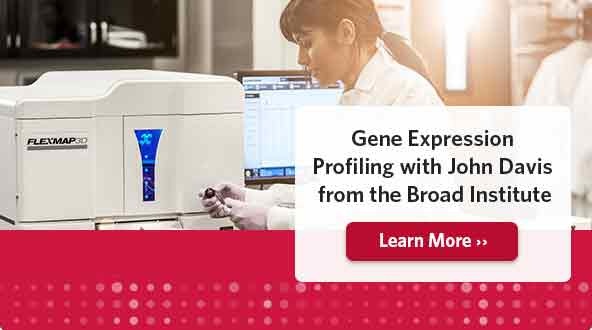xMAP® Technology lowers costs and sample input requirements while speeding time to results

Luminex’s xMAP® Technology is used for a broad range of applications, and we’re delighted to see that many customers are applying the multiplexing approach to high-throughput gene expression measurements — saving money and getting faster results compared to qPCR.
The Broad Institute’s Connectivity Map
This approach was well-documented in a paper last year from scientists at the Broad Institute and collaborating institutions. The Cell publication described a massive effort to expand the pilot version of a Connectivity Map (cmap) — showing gene expression connections among genes, drugs, and disease states — to a more robust and representative version. The scientists succeeded in brilliant fashion, generating 1.3 million profiles for a Connectivity Map that is 1,000 times more informative than the original. To accomplish this, they designed a reduced-representation method that uses nearly 1,000 gene expression landmarks to infer activity of the broader transcriptome. The approach was made possible via the FLEXMAP 3D® platform, an xMAP-based system that can detect 500 unique bead colors. By using two sets of barcodes, the team was able to measure transcripts for all landmarks in one workflow. The assay “directly measures 978 genes and infers 11,350 more, for a total of 12,328 genes,” the team reported, making quick work of the data needed for the dramatically expanded cmap.
Multiplexing is Less Expensive and Much Faster than qPCR
Other recent papers have used similar bead-based approaches for measuring gene expression. In a study of zebrafish larvae, scientists used our MAGPIX® system to identify gene expression changes triggered by oxidative stress. The team also conducted a thorough analysis of cost, time, and tissue requirements for this approach, finding that studies of more than a dozen genes are less expensive and much faster using bead-based methods, and also require significantly less tissue (see Table 2 in the paper). For example, this approach can analyze up to 80 genes from as many as 46 samples in an hour, while a qPCR technique “requires an hour per single gene analyzed,” the scientists report.
More Gene Expression Studies
For more examples, check out work from researchers at the NIH Center for Advancing Translational Sciences and collaborators reporting the development of high-throughput gene expression assays intended to monitor the progression of induced pluripotent stem cells as they mature and differentiate. The team used the FLEXMAP 3D system to measure the expression of many genes in a single reaction. Or this publication from scientists at Merck who used the same method to conduct high-throughput gene expression screening of colon cancer cells exposed to an extensive library of chemicals.
Congratulations to these scientists and many others whose creative use of xMAP Technology is making it possible to increase throughput and reduce costs for essential gene expression workflows!
Resources
- Getting Started with xMAP® Technology [VIDEO]
- Browse 1,200+ Partner Kits with xMAP® Kit Finder [ONLINE TOOL]
- xMAP® Cookbook to Design Your Own Assays [DOWNLOAD]
- Webinar Wednesday: John Davis from the Broad Institute [BLOG & VIDEO]
Subscribe to the blog to stay on top of all the latest Luminex news.
